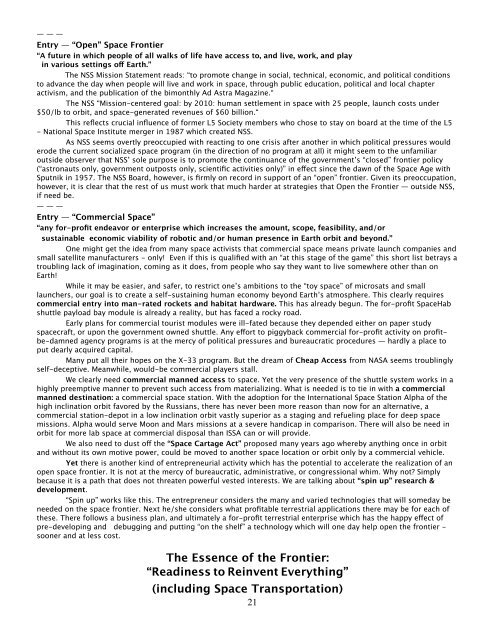Space Transportation - mmmt_transportation.pdf - Moon Society
Space Transportation - mmmt_transportation.pdf - Moon Society
Space Transportation - mmmt_transportation.pdf - Moon Society
Create successful ePaper yourself
Turn your PDF publications into a flip-book with our unique Google optimized e-Paper software.
— — —<br />
Entry — “Open” <strong>Space</strong> Frontier<br />
“A future in which people of all walks of life have access to, and live, work, and play<br />
in various settings off Earth.”<br />
The NSS Mission Statement reads: “to promote change in social, technical, economic, and political conditions<br />
to advance the day when people will live and work in space, through public education, political and local chapter<br />
activism, and the publication of the bimonthly Ad Astra Magazine.“<br />
The NSS “Mission-centered goal: by 2010: human settlement in space with 25 people, launch costs under<br />
$50/lb to orbit, and space-generated revenues of $60 billion.“<br />
This reflects crucial influence of former L5 <strong>Society</strong> members who chose to stay on board at the time of the L5<br />
- National <strong>Space</strong> Institute merger in 1987 which created NSS.<br />
As NSS seems overtly preoccupied with reacting to one crisis after another in which political pressures would<br />
erode the current socialized space program (in the direction of no program at all) it might seem to the unfamiliar<br />
outside observer that NSS’ sole purpose is to promote the continuance of the government’s “closed” frontier policy<br />
(“astronauts only, government outposts only, scientific activities only)” in effect since the dawn of the <strong>Space</strong> Age with<br />
Sputnik in 1957. The NSS Board, however, is firmly on record in support of an “open” frontier. Given its preoccupation,<br />
however, it is clear that the rest of us must work that much harder at strategies that Open the Frontier — outside NSS,<br />
if need be.<br />
— — —<br />
Entry — “Commercial <strong>Space</strong>”<br />
“any for-profit endeavor or enterprise which increases the amount, scope, feasibility, and/or<br />
sustainable economic viability of robotic and/or human presence in Earth orbit and beyond.”<br />
One might get the idea from many space activists that commercial space means private launch companies and<br />
small satellite manufacturers - only! Even if this is qualified with an “at this stage of the game” this short list betrays a<br />
troubling lack of imagination, coming as it does, from people who say they want to live somewhere other than on<br />
Earth!<br />
While it may be easier, and safer, to restrict one’s ambitions to the “toy space” of microsats and small<br />
launchers, our goal is to create a self-sustaining human economy beyond Earth’s atmosphere. This clearly requires<br />
commercial entry into man-rated rockets and habitat hardware. This has already begun. The for-profit <strong>Space</strong>Hab<br />
shuttle payload bay module is already a reality, but has faced a rocky road.<br />
Early plans for commercial tourist modules were ill-fated because they depended either on paper study<br />
spacecraft, or upon the government owned shuttle. Any effort to piggyback commercial for-profit activity on profitbe-damned<br />
agency programs is at the mercy of political pressures and bureaucratic procedures — hardly a place to<br />
put dearly acquired capital.<br />
Many put all their hopes on the X-33 program. But the dream of Cheap Access from NASA seems troublingly<br />
self-deceptive. Meanwhile, would-be commercial players stall.<br />
We clearly need commercial manned access to space. Yet the very presence of the shuttle system works in a<br />
highly preemptive manner to prevent such access from materializing. What is needed is to tie in with a commercial<br />
manned destination: a commercial space station. With the adoption for the International <strong>Space</strong> Station Alpha of the<br />
high inclination orbit favored by the Russians, there has never been more reason than now for an alternative, a<br />
commercial station-depot in a low inclination orbit vastly superior as a staging and refueling place for deep space<br />
missions. Alpha would serve <strong>Moon</strong> and Mars missions at a severe handicap in comparison. There will also be need in<br />
orbit for more lab space at commercial disposal than ISSA can or will provide.<br />
We also need to dust off the “<strong>Space</strong> Cartage Act” proposed many years ago whereby anything once in orbit<br />
and without its own motive power, could be moved to another space location or orbit only by a commercial vehicle.<br />
Yet there is another kind of entrepreneurial activity which has the potential to accelerate the realization of an<br />
open space frontier. It is not at the mercy of bureaucratic, administrative, or congressional whim. Why not? Simply<br />
because it is a path that does not threaten powerful vested interests. We are talking about “spin up” research &<br />
development.<br />
“Spin up” works like this. The entrepreneur considers the many and varied technologies that will someday be<br />
needed on the space frontier. Next he/she considers what profitable terrestrial applications there may be for each of<br />
these. There follows a business plan, and ultimately a for-profit terrestrial enterprise which has the happy effect of<br />
pre-developing and debugging and putting “on the shelf” a technology which will one day help open the frontier -<br />
sooner and at less cost.<br />
The Essence of the Frontier:<br />
“Readiness to Reinvent Everything”<br />
(including <strong>Space</strong> <strong>Transportation</strong>)<br />
21















